Setting up centers in preschool and kindergarten classrooms can be a pretty daunting task. Especially if it’s your first time doing so (although it’s no small feat for veteran teachers, either).
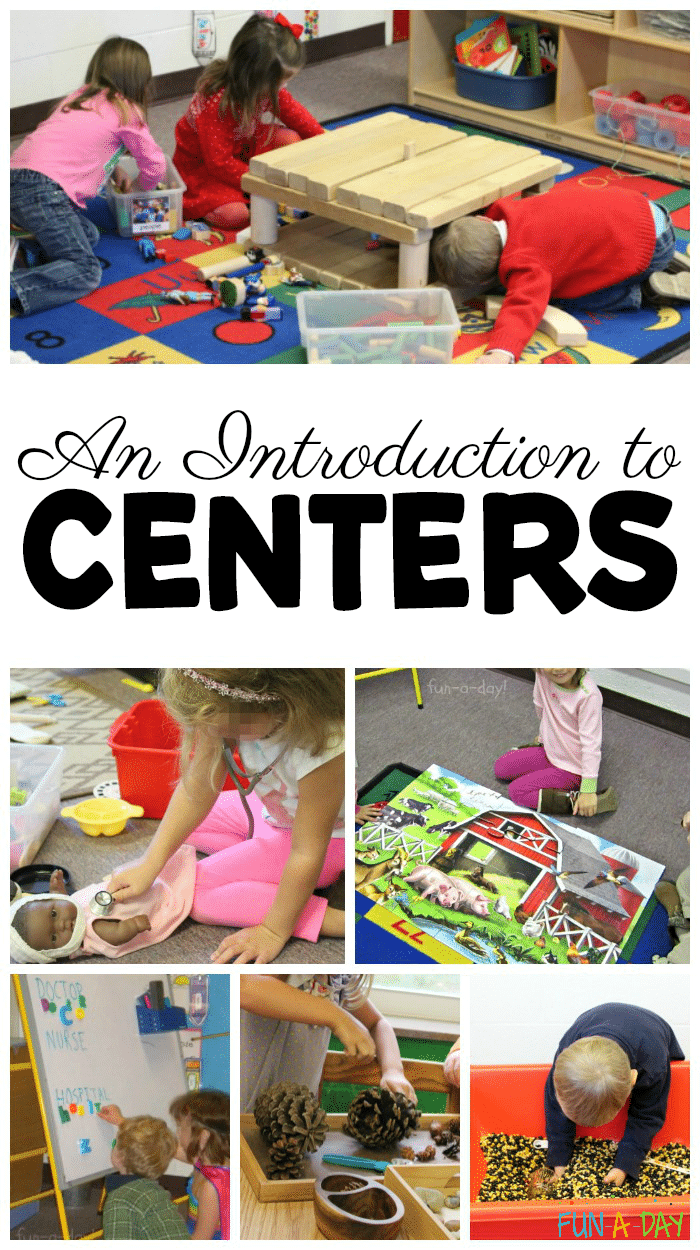
I may get commissions for purchases made through links in this post.
I get quite a few questions about centers from awesome readers who are a little overwhelmed at the prospect of putting centers together in their early childhood classrooms.
One of the reasons for that overwhelm, in my opinion, is trying to figure out everything at once. Let’s start here, with what I like to call “a basic introduction to centers” (there’s a much more in-depth centers guide here if you’re interested).
We’ll be touching on what centers in preschool and kindergarten classrooms are, why they’re important, and we’ll even look at some examples.
Ready? Let’s get started!
What in the World are Centers Anyway?
The term “centers” can mean a few different things, but they’re all about the same general concept.
Centers are activities located in specific areas around the classroom. Often, each specific area is also referred to as a center. The time period on the preschool schedule for these activities is also often called centers.
Children work in small groups during center time, and they can also work independently.
Depending on your preference, some center activities can be done with the teacher, while others are completed with peers or individually.
Centers can be done at one time during the school day, with a variety of center topics available. Centers can also be split up into different parts of the day. For example, literacy centers might be held in the mornings, with art centers after lunch. The decision is based on teacher preference and class schedule.
Why is it Important to Have Centers in Preschool and Kindergarten Classrooms?
There are so very many reasons to have centers in early childhood classrooms!
I’m going to touch on a few of them here, but please keep in mind this isn’t an exhaustive list.
Preschool Centers Help Kids Grow Socially
To begin with, center time allows children to grow in their social skills. They navigate interactions with their peers during this time, and it is happening almost constantly. Here are just some of the ways centers help children socially:
- Kids need to find a way to join in on play that’s already established at one center.
- They need to negotiate the guidelines to what they’ll be doing in the center.
- One child may want some time to herself at a center, and she needs to express that to her friends.
- Children constantly work on who is using what material at any given time, and if they’re willing to share that with some friends.
- When it’s time to clean up, the kids need to divvy up who will be responsible for what task.
- A child might be struggling with a task he very much wants to do. He can ask a friend for help, a friend could offer to help, or some combination thereof.
Centers in Preschool Help Kids Become More Self-Aware
In addition to the social aspect of centers, children are learning a lot about themselves at this time. They’re practicing and exploring many important concepts in a safe environment. Here are some:
Time management
Time management is one big part of centers. If your centers last an hour, and a child knows she wants to go to the math center AND the science center that day . . . well, she needs to figure out how to accomplish that.
Self-Regulation
An amazing amount of self-regulation is practiced during center time. There is always some friction when children are sharing an area and materials. There’s a back-and-forth that the kids need to navigate, and sometimes that can be frustrating.
So the kids have to keep an eye on how they’re talking to their peers, keeping their hands to themselves, and even regulating their own emotions throughout center time.
Their Own Interests
Kids can take the time to explore what they’re interested in. Since each center should be stocked with different kinds of materials, the children can determine what they like and don’t like.
Maybe one child loves painting, while another is a big fan of clay. Both can get the chance to express their own interests in the same art center.
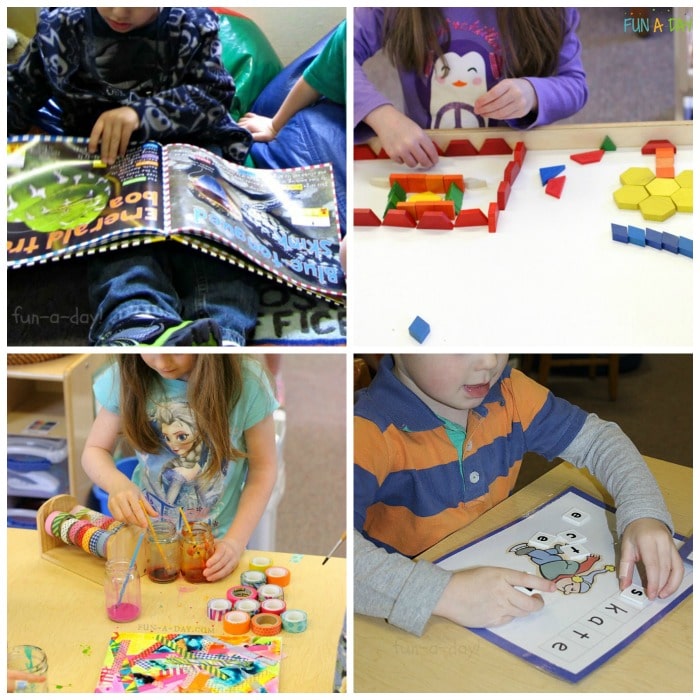
Find the Centers Guide with Printable Center Signs here
Centers in Preschool and Kindergarten Help Kids Learn
Of course early childhood centers also help children when it comes to early learning skills. As with the social and self development concepts listed above, there are so many ways centers help with early academics:
Make Mistakes
Center time is a safe place to make mistakes. This seems like such a small aspect of the conversation, but it is so very important.
Mistakes are a part of the learning process, and center time allows for a low-stress time for them.
Practice, Practice, Practice
Children get to practice concepts they’ve been taught during centers in preschool. For example, say a child is learning to count to 10. She can explore this concept as she counts the blocks of a structure she made in the block center.
Playing with the animal counters in the math center will give her more time to explore the concept. Maybe she and her friends are setting the table for 10 people in the dramatic play center. Yet another chance to meaningfully practice the concept.
Extend the Learning
Kids can also extend early learning concepts. If a child’s mastered the basic AB pattern, maybe he’ll go on to playing with the more complicated ABB pattern.
Learn New Skills
New-to-them skills will also crop up while children are playing and learning in centers. These are the “Ah ha!” moments, and they are blast to observe in classroom centers.
“Did you know that when you mix the red paint with the blue paint, you get purple?!” “There are 10 letters in my name, but only 4 in her name.”
Develop Language
And we can’t forget to talk about the language development that happens during center time. Because preschool centers allow children to interact with their peers so much, there is almost constant discussion between kids.
Even children who don’t like to talk as much, or who are learning a new language, benefit from this.
Speaking, listening, learning new vocabulary, hearing the flow of language, learning how to take turns during a conversation – these are all important language skills.
Take a Look at Some Centers in Preschool & Kindergarten
I’ve used a variety of centers in preschool and kindergarten classrooms over the years. I bet you have too! Below are some centers that an early childhood classroom could include.
These are just the general centers to have around the classroom. The specific activities would change based on your theme or project, the time of year, your students’ needs, etc.
Keep in mind that this is not an exhaustive list!
Reading Center
A cozy spot set up in the classroom, with a variety of books available for the children to read.
Books related to the theme, class-made books, big books, interactive writing charts, and pocket chart poems are just some of the things that can be included in the reading center.
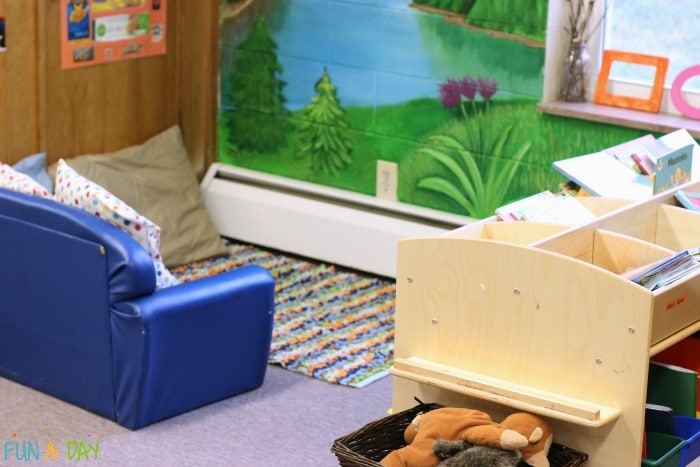
Writing Center
A place where students can practice the various stages of writing. Sometimes this center is “free writing”, with the kiddos deciding what to do. Other times, the activity is teacher-directed.
Some ideas include making words with letter tiles, writing in journals, writing in sand, and book-making.
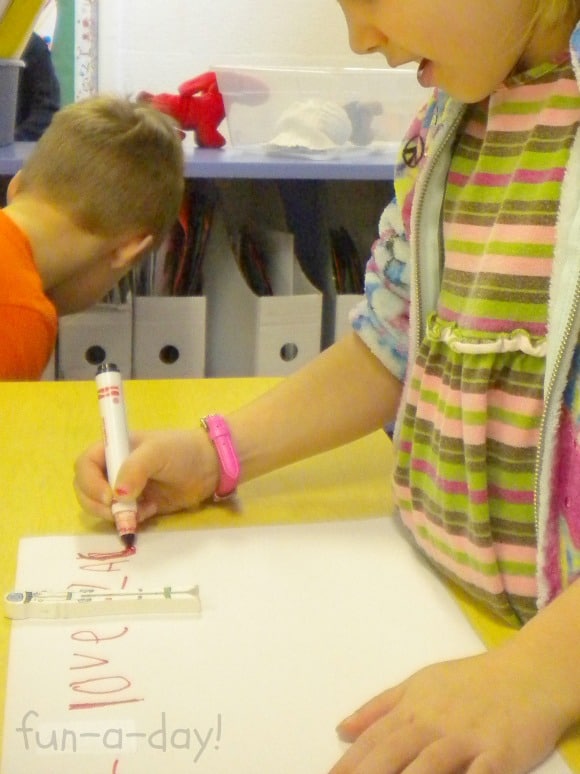
Related: Preschool Winter Words Free Printable to Use with Letter Tiles
Dramatic Play Center
A center just for pretend play, some of my kids referred to it as the home center.
“Kitchen appliances”, a table, and chairs set the backdrop for this center.
Some ideas for the home center are acting out favorite stories, running a flower shop, selling produce in a roadside stand, and caring for patients in the ER.
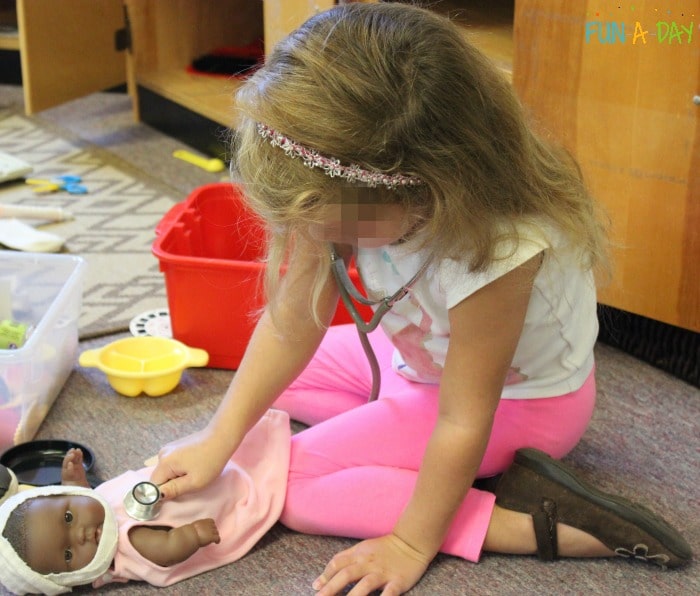
Building Center
Having a large spot set-aside for building and creating is an important part of early childhood classrooms. Building can include blocks, racetracks and cars, Lego (although sometimes people keep these in the math or fine motor area), and so many other creative building supplies.
The children can have free reign to build whatever they wish, or they can build within certain guidelines. Sometimes I like to give a suggestion to the kids, then let them go.
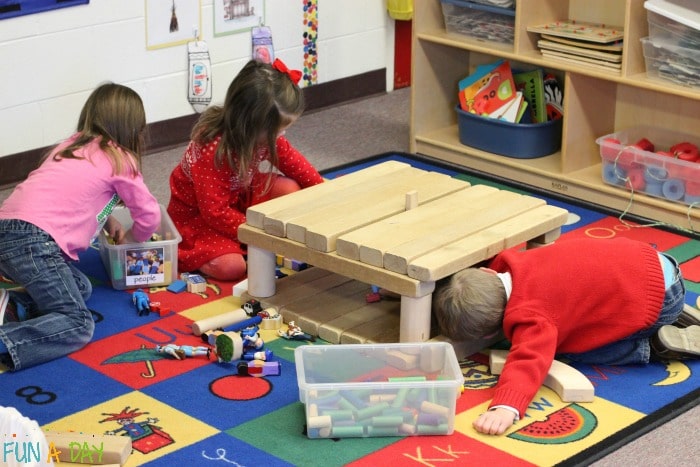
Related: How to Stock and Organize the Preschool Block Center
Art and Crafts Center
The purpose of this center in preschool is to let the kids explore their creativity.
For this center, you might put out art materials the kiddos can use with minimal supervision. Or some days you might introduce a new art technique or material that requires and adult to hang out for most of center time.
Students might paint self-portraits, make play dough, or paint with corn cobs. Children might see what happens when they mix different paint colors, or maybe they want to experiment with mixed-media art or sculpture.

Related: Colorful Tape and Watercolor Art for Kids
Sensory Center
The sensory center in preschool helps kids focus in on (you guessed it!) their senses.
This center might hold water, rice, shaving cream, beads, straws, dyed corn in a rainbow of colors, and so much more.
Ideally, the materials would be rotated so that different senses are explored throughout the year.
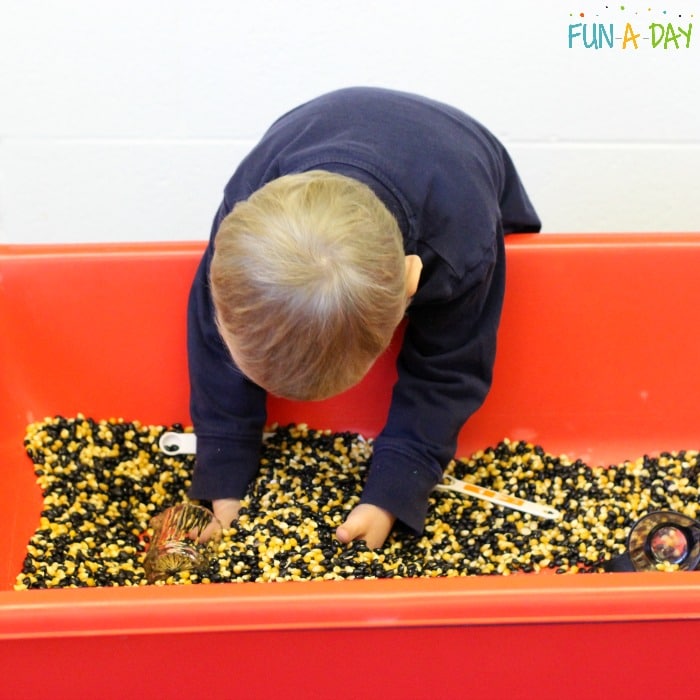
Related: Rainbow Activity with Colorful Corn
Science Center
The science center in preschool helps the children learn to investigate the world around them. I love stocking this center with magnifying glasses, tweezers, and kid-sized safety goggles.
Depending on what your class is learning, you might have pumpkins to dissect, rocks, shells, insects to observe, or snake skins in the center.
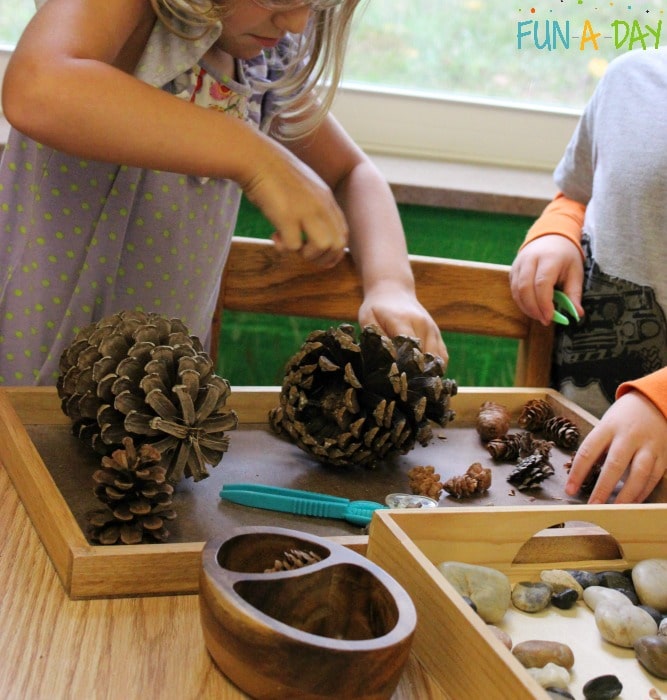
Related: Insects and Plants in the Preschool Science Center
ABC Center
This center allows children to explore letters — how letters look, how they compare to each other, how they combine to form words.
If you have a teacher easel with a magnetic white board, that’s perfect for this little center. Sometimes I have the children sort magnetic letters, match uppercase to lowercase letters, make words, write words, work with word families, etc.
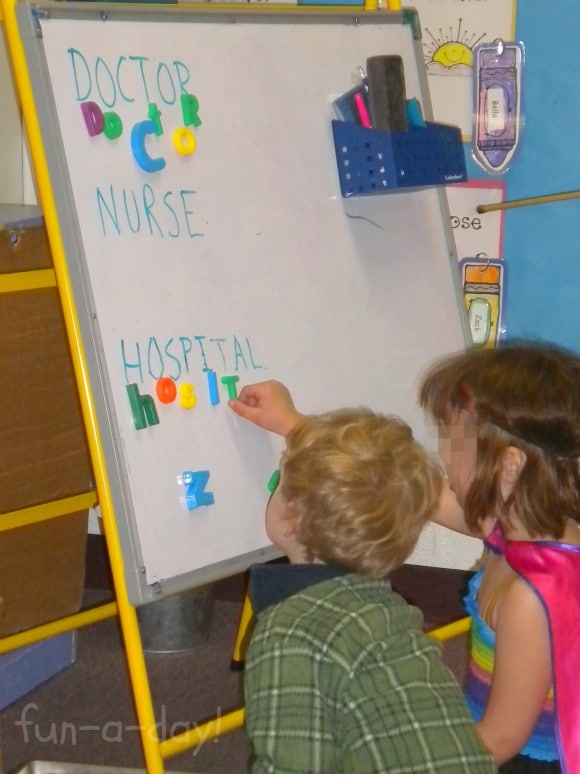
Related: Sorting Magnetic Letters
Math Center
Kiddos use this center in preschool to learn more about shapes, colors, numbers, quantities, and such.
Some ideas for this center include playing dice games, sorting jelly beans, matching numeral cards to quantities of items, sorting items, etc.
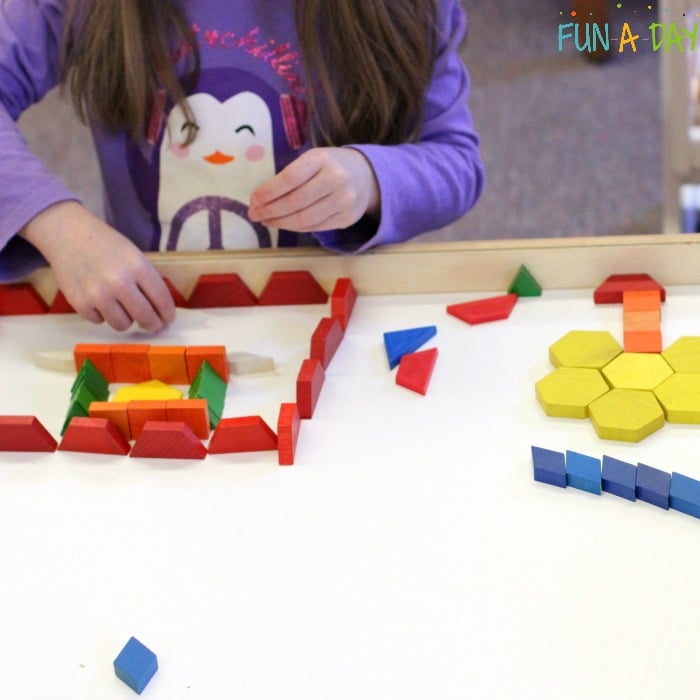
Related: Spring Math Game for Kids
Puzzles & Games Center
It’s always fun for the kiddos to work on puzzles or play games together. Fun, cooperative play!
I don’t always have a center set aside just for puzzles and games. It really depends on the size of the classroom and my center time goals.
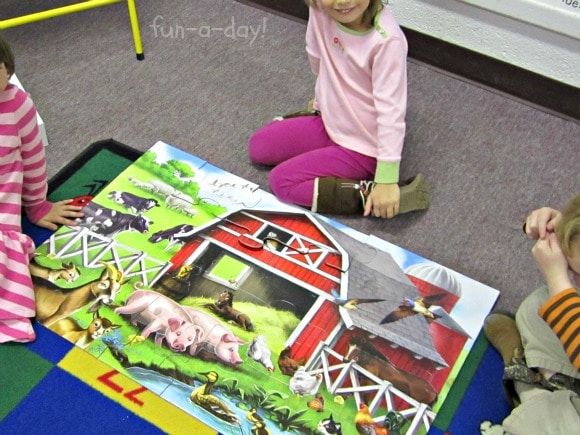
Teacher Center
This is a a center that I’ve often had for me, a teaching assistant, or a co-teacher to oversee. Not every year, but some years. For years when there wasn’t space for a dedicated “teacher table”, we would just move around to another center that made sense.
This center is often for working with the kids on their name kits, writing in their journals, making books, creating special art projects, and many other activities.
Sometimes we work with the children in small groups, while other times we pull children over individually. A lot of individualized teaching takes place here!

It’s Your Turn
What centers are in your early childhood classroom? Do you have anymore questions regarding centers in preschool or kindergarten classrooms? If you’re reading for more, be sure to pop over and read about how to manage preschool and kindergarten center time.
Feel free to touch base with me!
Related: Talking to Parents about Early Childhood Centers
Amazing Resource for Your Centers in Preschool
As I mentioned above, I’ve had many readers looking for help with centers. If you’d like all the whys, hows, and to-dos in one place, along with a ton of printable center cards and signs, you need to check out this Preschool Centers Guide. Keep in mind, this would work great in other early childhood classrooms too! Below the photo you’ll see what comes in the 200+ page guide.
What’s Included
50 page planning guide
This teacher guide delves into what centers are, why they’re important, ideas for managing centers, how to set up centers in preschool, ideas for stocking centers, and how to introduce them to your students.
This planning guide would be great to print out and add to a teacher binder, or get them printed and bound separately to keep for reference in the classroom.
Printables for managing and labeling centers
There are a wide variety of centers included in these printables. This way, you can pick and choose what you need for your own classroom each year.
Here are the printables included along with the teacher guide:
- Large Center Signs
- Square Center Cards
- Center Choices Checklists
- Center Rules (with an editable option)
- Large Centers Signs with Room for Students to Add Name Cards
- Editable Student Name Cards
- Center Sign Up Sheets
- “Work in Progress” Signs
- “Book Hospital” Labels
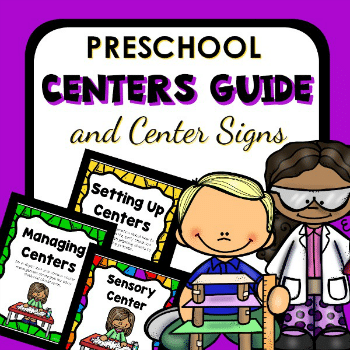
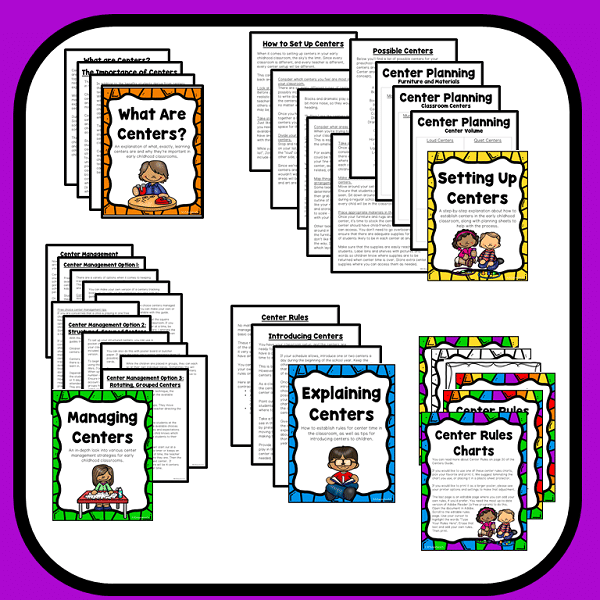
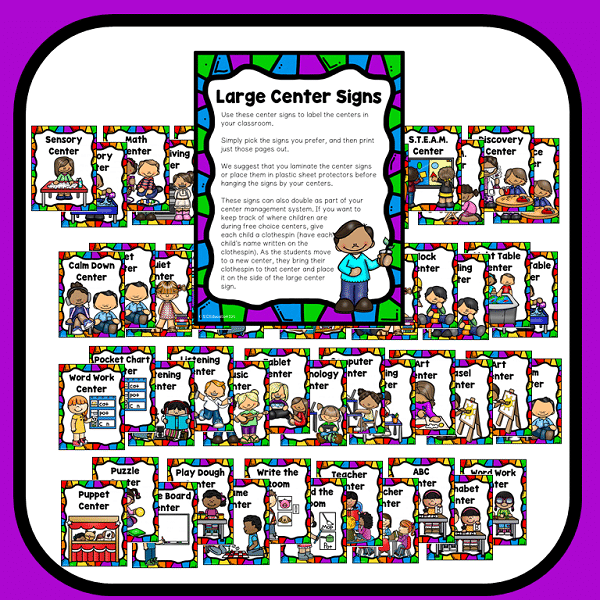
Love all your learning centers!
Thank you! 🙂
Super cute ideas!
Thanks so much, Kimberly!
This is actually how we are setting our house up right now and reorganizing. Liam seems to enjoy centers best!
Oh, how fun, Sarah! I hope Liam has a blast with your centers! Most kiddos I know love centers too!!
What are book boxes? I love the idea of group centers. Less fuss about who to play with and where!
Book boxes are just how the kiddos store the books they’re reading, along with books they’ve made. 🙂
I am a new preschool teacher and I am finding your site so helpful! Thank you for all the great tips 🙂
Glad I can help! 🙂
Love your really cool, child friendly learning centers.
This is what am looking for I love it! Thank you.
Glad I could help! 🙂
As a former kindergarten teacher, a great with how you covered it all! Bravo! Great tips!
Thanks, as always, for your supportive and kind words, Devany!
Very informative and full of creative ideas, A complete guideline for beginners. Well Done!
Thank you so much for the kind words, Shahla!